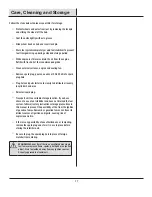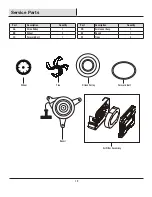
Operation (continued)
Handle Height Adjustment
□
To adjust the tiller height, loosen the plastic wing nut,
select the appropriate hole for height and tighten.
See Figure 1-8.
8
13
Height adjustment
Plastic Wing Nut
Figure 1-8.
Tilling Tips
□
□
□
□
□
□
□
□
The key to successful tilling is to begin with a shallow cut
on the first pass, and then work an inch or two deeper on
each successive pass.
Tilling depth will vary with ground conditions.
When beginning to till in unbroken ground or in extremely
hard soil, set the cleves pin in the highest hole of the depth
regulator. This will allow for shallow tilling. With the depth
regulator in this position, make several light passes over
the area to be tilled. Reset for deeper depths with successive
passes.
If tiller jumps or skids uncontrollably, lower the depth
regulator by placing the cleves pin in a higher hole. This will
allow for shallower tilling. Hold firmly to the handlebars to
control sudden lurches.
If weeds, tall grasses, vines, or other materials clog or jam
the tines, reverse the tiller to unwind vegetation.
Immediately release the drive control levers if the tines jam
or you strike a foreign object. With the drive control levers
in the neutral position, push throttle control to the stop
position to stop the engine. Disengage the spark plug wire.
When tines have stopped, remove foreign objects and check
for damage.
Plant rows on 20" - 22" centers for ease of turning.
Set the depth regulator lever with the detent pin in one
of the higher holes. This will allow for shallow cultivation
necessary to turn over weeds, and break up and aerate
the soil.
9
CULTIVATING
CAUTION:
Before adjusting the handle bar, place the tiller
on firm level ground to prevent the handle from collapsing
accidentally.





































